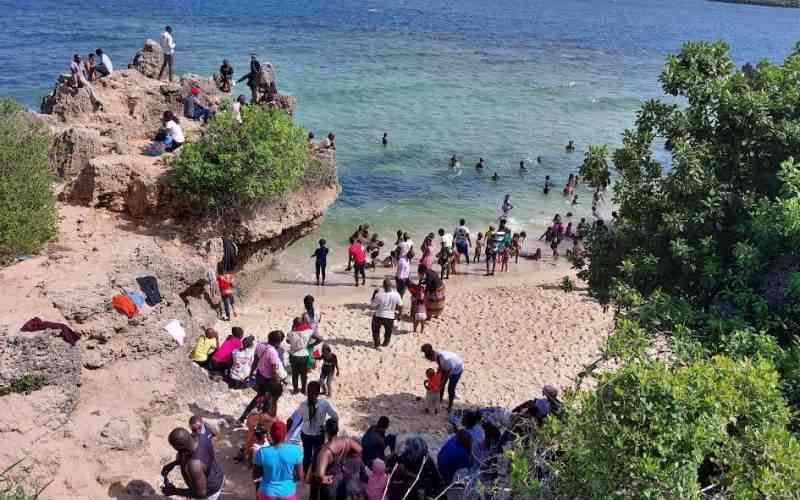
If you are visiting the coastal region, and are near Mombasa Island, Mama Ngina Waterfront Park is an ideal place to visit - it needs no prior planning or arrangement as the Sh460 million-regenerated Park was created with the public in mind.
Unlike Nairobi, Mombasa is turning into an excellent city, where things work on set standards. The organisation of the PSVs, taxis, and private transport to pick up passengers from SGR Mombasa terminal speaks volumes about an organised system.
Alongside the rejuvenated parks and recreational facilities, new ones have flourished with key tourist attraction sites for both local and international visitors. Mama Ngina Waterfront is easily the best of them all. If you are driving, there is a large parking lot outside. No visitor vehicles are allowed within the park. Entry to the park is free.
At the Likoni channel crossing, the point of entry to the park, a jetty that has been purposely constructed for the water taxis and a living boat museum. Most of the structures are a display of coral stone, Swahili-style lime plaster, precast concrete screens, and frames, donned with hardwood, and timber complete with Mangalore roofing tiles. The regeneration of the park has transformed the formerly sleeping Mama Ngina giant park, also achieving the preservation of Swahili Coastal culture and heritage.
From its initial layout of a watching bay area carved out of a small rising cliff facing the Likoni channel, the waterfront park has now a properly built natural amphitheatre, a cultural centre, and a sun-drenched 2.1km long promenade and a space for food vendors. Along the seafront, are guardrails, creatively designed to separate and offer a protective safety guard from the cliff face, a few metres above the pounding sea waves.
The guardrails provide a safe watching ground. A few visitors disregard the warning signs to not go beyond or sit on the rails, disregarding their safety. It is an incredible experience that sometimes will catch your breath as you walk along the well paved, and palm-lined pedestrian pathways, which create the perfect environment for exercising.
This place is ideal for serene walks, runs, and group, family, or individual outings. I am lost for words to explain the extraordinary features, some of which are mounted strategically placed to explain key historical happenings of this more than 400 years Swahili hub.

Rich history
The National Museums of Kenya, who are the custodians of the archaeological and heritage sites, gazetted the Mama Ngina Waterfront Park in 2005 to preserve it. However, in time the park lost its lusciousness before coastal leaders appealed to former President Uhuru Kenyatta to rejuvenate the Park.
The 26-acre park is now famed for being a special place where tourists can relax, and watch the world-class ships passing by as they arrive and leave the port of Mombasa. The park faces the Likoni crossing channel and is home to Kenya's oldest golf course, the 1911-established Mombasa Golf Club. Mama Ngina Waterfront Park holds a rich history of Mombasa town that dates back to the 15th Century.
While to many visitors, the park is a spot where revellers go to picnic and relax, others visit to do research and connect with history. Beneath the park, are ancient archaeological remnants that archaeologists say provide an important lesson about the development of the port city of Mombasa.
The archaeological evidence indicates that Mama Ngina Park was the foundation of the city of Mombasa. At the furthest end of the Park's area, behind the Coast Police Headquarters, historians, say, lies the untold story of Mombasa Island. It is a story that tells of the ruins of a church - St Johns ACK, which is believed to be the first one in Mombasa, built by the Portuguese.
The building still stands intact on a cliff at the Mama Ngina Waterfront. It has stood the test of four centuries of weather bombardment. Next to the ruins of the ACK church, is the St Joseph fortress and another unnamed building that too, has stood the test of time. There are also underground tunnels, and caves that were used by the Arabs during the slave trade period.
The caves were used as holding grounds before the slaves were sold off abroad. After the invasion by the Portuguese, the tunnels and caves were used as underground bunkers used by the Portuguese to launch their attacks on the Arabs and natives. Today, these spaces are used as shrines and sometimes as hiding places by criminal elements.
 The Standard Group Plc is a multi-media organization with investments in media
platforms spanning newspaper print
operations, television, radio broadcasting, digital and online services. The
Standard Group is recognized as a
leading multi-media house in Kenya with a key influence in matters of national and
international interest.
The Standard Group Plc is a multi-media organization with investments in media
platforms spanning newspaper print
operations, television, radio broadcasting, digital and online services. The
Standard Group is recognized as a
leading multi-media house in Kenya with a key influence in matters of national and
international interest.
